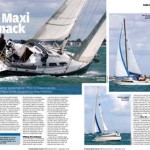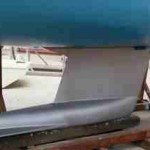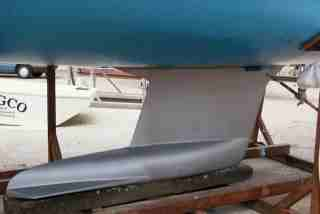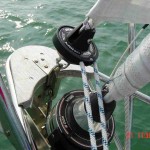Replacement of the sail-drive gaiter is a recurring task for Maxi owners and one that is costly through a yard. Malcolm (Denny) Denham has done it himself on his Maxi 1100 and has kindly shared with the group his experience. The pdf file below includes the lessons learned and has pictures through the procedure while the Excel file includes materials used and time taken.
https://maxiowners.net/wp-content/uploads/2022/04/Saildrive-diaphragm-replacement.pdf
https://maxiowners.net/wp-content/uploads/2022/04/Saildrive-diaphragm-change.xlsx
Many thanks Denny for sharing with the group.
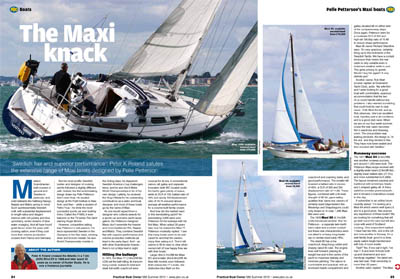 Practical Boat Owner Volume 589 (Summer 2015) contains a comprehensive review written by Peter K Poland of all Pelle Petterson’s Maxi boats, starting with the original Maxi 77 through to the Maxi 1300 and Maxi 1200. We are extremely grateful to the Editor of PBO and to Peter Poland for granting us permission to reproduce this as a PDF.
Practical Boat Owner Volume 589 (Summer 2015) contains a comprehensive review written by Peter K Poland of all Pelle Petterson’s Maxi boats, starting with the original Maxi 77 through to the Maxi 1300 and Maxi 1200. We are extremely grateful to the Editor of PBO and to Peter Poland for granting us permission to reproduce this as a PDF.
To view it, please click here.
A Tale of Two Keels – A Maxi 1100 has a keel transplant!
A comparison between a long and shallow keel by Chris Wildey
We first saw the Maxi 1100 when it was launched at the LBS but were disappointed it was not available with less than a 2m keel – even though the brochure listed a 1.5m option! As our home cruising ground is in the East Coast’s shallow waters, we carried on looking for our ideal boat over the next year or so. Then in Autumn 2000 as we were trekking around Hamble Point’s brokerages, we were accosted by Roger who said of course we could have 1.5m and with the same rig! Although we are not normally keen to be "guinea pigs", after a few days hesitation and a test sail in the 2m version, we put our trust in Maxi’s hands and promptly ordered Vouvray.
Our plan was to take delivery just before our summer holiday, and then to cruise the Channel Isles to give Vouvray a thorough shake down before taking her back to the River Orwell. However, due to Maxi’s quality control rejecting the first keel casting, we agreed our boat would be delivered with a full fin keel to allow Roger time to commission her before performing a keel transplant immediately prior to our holiday cruise. As events turned out, we ended up on holiday with the deep fin, with the operation being carried out immediately we returned.
Hence we had 4 weeks or so deep fin experience, plus the worry of whether we would then notice any loss of sparkle or performance with the shallower draft. We really did not want to know what sacrifice we were making. During our holiday, we certainly revelled in her fast performance, and made an excellent Cherbourg- Brixham passage in 14 hours – an excellent way to avoid the monotony of crossing Lyme Bay! Would all this be lost with the new keel?
Roger arranged Vouvray’s delivery to our berth in the Orwell, and that was where we nervously tried out our new keel. We need not have worried. Vouvray still sailed beautifully, and handling differences were not apparent although by careful watching of the GPS track, the wake, etc., we have been able to make a few quantitative observations. She sails just as close to the wind as before, but inevitably, there are a couple of degrees of extra leeway: before, leeway was barely noticeable whereas now it is perhaps as much as 5 degrees, especially if trying to pinch a little too much.
The new keel features a huge long torpedo with a couple of small winglets aft. The lead keel is around 300kg heavier and thus she sits just over 1cm lower. So maybe she’s a tad slower in lighter winds as a result, but we haven’t noticed any difference in passage making. In terms of stiffness, Maxi’s own curves show the two keels as yielding the same righting moment but our impression is that the shallow keel’s initial stiffness is actually higher: whether this is real (due to sitting lower perhaps, or greater inertia) or just our imagination, we’ll never know!
The rudder is also slightly shorter, but just as well balanced as before. In marinas, she handles just as tightly although we’ve not yet dared to mimic Mike’s knack of parking backwards in a tight berth. We’ve already had the benefit of the shallower keel, getting into and out of the Deben, Ore/Alde, and Southwold entrances, and over the sills at Titchmarsh and Tidemill at times that suit us. We haven’t yet tried sailing through the mud as we used to with Tamarisk, our ten year old Moody 31: maybe with the big torpedo cross section, it might prove just too sticky!
We’ve already had a lot of fun sailing along the coast and up the river Orwell, smugly overtaking all the other boats in sight, even a few bigger ones, by consistently being faster and pointing higher! In fact, one warning to give anyone helming the 1100 is to keep a sharp lookout in front of the mast because its amazing how quickly you overhaul other boats when you’ve got a 1 knot advantage compared to many others in the 30 ~ 40 foot range! For this new year, we’re hoping to explore more of the Dutch coast, especially since the North Sea seems to be much smaller than before!
SUPERTED IV ENDS SEASON IN STYLE
 The 2002 season was a successful one for Maxi 1100 Superted IV owned by Matt and Jean Findlay from Marchwood Yacht Club near Southampton. Superted was overall winner of Class 1 in the south coast’s premier two handed series run by the Royal Southampton Yacht Club. This popular series consists of eight races half of which are passage races and half of which are inshore or round the buoys. Two discards are allowed. Around 30 boats competed in class 1 which was won by Superted with four firsts, a third and a fourth, comfortably fending off some strong opposition from J105’s, J110’s and other go fast racers.
The 2002 season was a successful one for Maxi 1100 Superted IV owned by Matt and Jean Findlay from Marchwood Yacht Club near Southampton. Superted was overall winner of Class 1 in the south coast’s premier two handed series run by the Royal Southampton Yacht Club. This popular series consists of eight races half of which are passage races and half of which are inshore or round the buoys. Two discards are allowed. Around 30 boats competed in class 1 which was won by Superted with four firsts, a third and a fourth, comfortably fending off some strong opposition from J105’s, J110’s and other go fast racers.
Earlier in the season Superte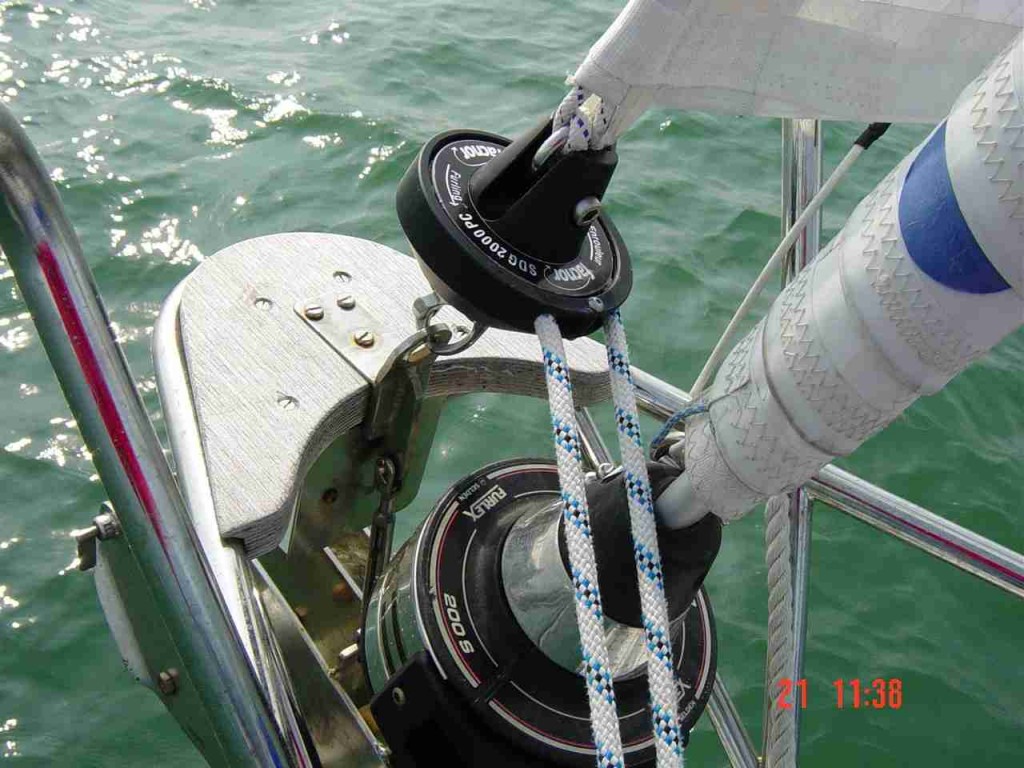 d sailed by father and son Matt and Matthew also won class 1 in the two handed Triangle race, (Torquay, Cork, Treguier and Torquay). An overall win was lost only because we took shelter in Falmouth (while out in front), to sit out an imminent gale which did not materialise.
d sailed by father and son Matt and Matthew also won class 1 in the two handed Triangle race, (Torquay, Cork, Treguier and Torquay). An overall win was lost only because we took shelter in Falmouth (while out in front), to sit out an imminent gale which did not materialise.
Superted uses Vectran/Kevlar sails by Sobstat with a 105% jib. We carry a medium and heavy spinnaker and this year added a removable furling Code Zero made by White Sails at Warsash. See pictures. The zero has an area of around 57m (IRC formula), and is made from taffeta backed Mylar. It’s mounted on a Facnor furler (SDG2000PC) which is shackled to a specially designed fitting ahead of the jib. The luff of the sail is set up very tight, and the fitting transmits the load directly to the stem head. The sail gives good additional boat speed between 55 – 90 degrees apparent and we’ve us ed it up to 18 knots apparent wind, though its designed for a bit less! (It also goose wings very nicely when cruising, and is easy to furl away).
ed it up to 18 knots apparent wind, though its designed for a bit less! (It also goose wings very nicely when cruising, and is easy to furl away).
It has taken a couple of years to really get the boat to go and to optimise the sail plan. We’ve found that there is a very fine line between pointing and going fast with the small jib. It’s a lot harder than using a large Genoa. In our quest to overcome the light wind blues, we considered going the large Genoa route, but opted for the code zero approach as we are geared up for short handed sailing and wanted to avoid head sail changes and the increased handicap. As a result our rating of 1.000 makes us very competitive in stronger winds, and generally we can hang on in there even in the lighter stuff. I am sure the 1100 will also be competitive with the large overlapping Genoa provided it’s fully crewed and the headsail is changed efficiently when required. We would be very interested to hear the experience of those using the Genoa and to exchange views.
All this sounds very racy. It is, but in fact we equally enjoy fast cruising. We’ve notched up around 10,000 miles in the last three years!
Happy sailing. Matt and Jean Findlay.
